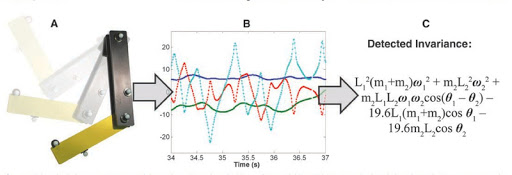A computer program itself discovers the laws of physics
Scientists from Cornell University have developed a program that can find natural patterns in an unordered data set. The system itself is able to pick up a formula that describes the pattern found. In other words, it can, without theoretical training, formulate the laws of physics, simply by observing the world around it.

The use of computational methods is especially important in those areas of science, where huge data arrays are collected, but there is still no theory that would describe all the results of experiments. And there are more and more such fields in biology, genetics, oceanography, cosmology, and in almost all natural sciences.
')
In general, this is not the first attempt to contract Artificial Intelligence to the discovery of mathematical theorems and laws of physics. All previous were unsuccessful.
However, the program from Cornell University still pinned certain hopes. There is a possibility that it really works more efficiently than all its predecessors. Unlike all of them, this development operates only with a limited basic set of mathematical rules. Unlike Dendral, the program is able to reduce the number of possible options to a small number of the most likely.
Analyzing data array. The program works in several stages. First, she randomly performs random arithmetic operations, trying to find a pattern. After this, it highlights the results that are less erroneous than the others, changes the algorithm, performs calculations again, selects the best options again, and so on.
Scientists have already checked the program in action. They have not yet published specific results, but consider them interesting.
via Wired

The use of computational methods is especially important in those areas of science, where huge data arrays are collected, but there is still no theory that would describe all the results of experiments. And there are more and more such fields in biology, genetics, oceanography, cosmology, and in almost all natural sciences.
')
In general, this is not the first attempt to contract Artificial Intelligence to the discovery of mathematical theorems and laws of physics. All previous were unsuccessful.
- Half a century ago, Herbert Gelernter from IBM wrote programs that supposedly formulated the laws of Euclidean geometry, but, according to critics, the program actually relied on too many predefined patterns, so these “discoveries” cannot be considered independent.
- In the 1970s, the Automatist Douglas Lenata program automatically generated many mathematical theorems, but all of them were found to be useless.
- As part of the Stanford project Dendral , launched in 1965, for twenty years, attempts have been made to molecular modeling possible organic compounds based on chemical data collected by the NASA spacecraft. The result was disappointing.
- In the 1980s, the Leibniz Prize was established in the amount of $ 100,000 for the creation of a program that will open at least some important mathematical theorem. The prize is not claimed until now.
However, the program from Cornell University still pinned certain hopes. There is a possibility that it really works more efficiently than all its predecessors. Unlike all of them, this development operates only with a limited basic set of mathematical rules. Unlike Dendral, the program is able to reduce the number of possible options to a small number of the most likely.
Analyzing data array. The program works in several stages. First, she randomly performs random arithmetic operations, trying to find a pattern. After this, it highlights the results that are less erroneous than the others, changes the algorithm, performs calculations again, selects the best options again, and so on.
Scientists have already checked the program in action. They have not yet published specific results, but consider them interesting.
via Wired
Source: https://habr.com/ru/post/56382/
All Articles